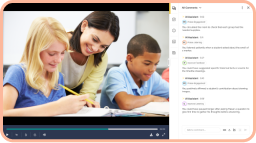Pacing |
Identifies and praises the rate of lesson delivery, lesson organization, clearly stated goals and expectations, variety of activities, checking for understanding, transitions, etc. |
Teacher Development |
Behavior Management |
Feedback on strategies and techniques teachers use to maintain an orderly and productive learning environment by promoting positive behavior and addressing disruptive actions |
Teacher Development |
Pacing |
Feedback on the rate of lesson delivery, lesson organization, clearly stated goals and expectations, variety of activities, checking for understanding, transitions, etc. |
Teacher Development |
Engagement |
Provide feedback for improving student engagement by: increasing passion and curiosity, scaffolding tasks, using physical movement, using a variety of mediums, good questions, etc. . |
Teacher Development |
Engagement |
Identifies and praises student engaging achieved by: increasing passion and curiosity, scaffolding tasks, using physical movement, using a variety of mediums, good questions, etc. . |
Teacher Development |
Listening |
Provides feedback on active listening skills, including avoiding interruptions, repeating or paraphrasing, reflecting back to student, asking clarifying questions, showing empathy, etc. |
Teacher Development |
Listening |
Identifies and praises active listening skills, including avoiding interruptions, repeating or paraphrasing, reflecting back to student, asking clarifying questions, showing empathy, etc. |
Teacher Development |
Feedback |
Identifies and praises meaningful feedback given to students by using precise and descriptive language, focusing on growth and improvement, recognizing effort and achievement, etc. |
Teacher Development |
Feedback |
Generates feedback on the meaningful feedback given to students by using precise and descriptive language, focusing on growth and improvement, recognizing effort and achievement, etc. |
Teacher Development |
Differentiated Instruction |
Identifies and praises tailoring teaching methods and activities to cater to the diverse learning styles and needs of students within a classroom |
Teacher Development |
Clear Instruction |
Identifies and praises providing explicit, concise and unambiguous directions to students, ensuring they fully understand what is expected of them in a task |
Teacher Development |
Differentiated Instruction |
Feedback on tailoring teaching methods and activities to cater to the diverse learning styles and needs of students within a classroom |
Teacher Development |
Clear Instruction |
Feedback on providing explicit, concise, and unambiguous directions to students, ensuring they fully understand what is expected of them in a task |
Teacher Development |
Classroom Procedures |
Feedback on teaching and reinforcing clear classroom routines and procedures |
Teacher Development |
Sequencing |
Identifies and praises the intentional order in which content is presented to students, building on prior knowledge and skills |
Teacher Development |
Sequencing |
Feedback on the intentional order in which content is presented to students, building on prior knowledge and skills. |
Teacher Development |
Classroom Procedures |
Identifies and praises teaching and reinforcing clear classroom routines and procedures |
Teacher Development |
Behavior Management |
Identifies and praises strategies and techniques teachers use to maintain an orderly and productive learning environment by promoting positive behavior and addressing disruptive actions |
Teacher Development |
Critical Questioning |
Identifies and praises a teaching technique that encourages students to think deeply and analytically by asking questions |
Teacher Development |
Critical Questioning |
Feedback on a teaching technique that encourages students to think deeply and analytically by asking questions |
Teacher Development |
Assessment |
Identifies and praises the process of evaluating students' learning, understanding, and progress (formative or summative) |
Teacher Development |
Assessment |
Feedback on the process of evaluating students' learning, understanding, and progress (formative or summative) |
Teacher Development |
Relational Development |
Identifies and praises the process of establishing a positive and trusting relationship with students, where both parties feel comfortable communicating openly. |
Teacher Development |
Relational Development |
Feedback on the process of establishing a positive and trusting relationship with students, where both parties feel comfortable communicating openly. |
Teacher Development |
Engagement |
Generates feedback about how to better engage the audeince using techniques like hooks, sharing stories, asking questions, using authentic language, making the topic personal, etc. |
Communication |
Engagement |
Identifies and praises where the audeince was well engaged by using techniques like hooks, sharing stories, asking questions, using authentic language, making the topic personal, etc. |
Communication |
Clarity |
Generates feedback about how to improve clarity of the message by using techniques like structure, providing context, minimizing weak or filler words, providing examples, repetition, etc. |
Communication |
Clarity |
Identifies and praises the areas that demonstrated clarity well by using techniques like structure, providing context, minimizing weak or filler words, providing examples, repetition, etc. |
Communication |
Vividness |
Generates feedback about areas where more vivid language could be leveraged using techniques like figurative language and sensory language. |
Communication |
Vividness |
Identifies and praises the areas that demonstrated vivid language by using techniques like figurative language and sensory language. |
Communication |
Relevance |
Generates feedback for improving the relevance of the message through relevance statements, evidence, examples, personal stories, testimonials, actionable recommendations, etc. |
Communication |
Relevance |
Identifies and praises the areas that demonstrated relevance of the message through relevance statements, evidence, examples, personal stories, testimonials, actionable recommendations, etc. |
Communication |
Questions Asked |
Identifies the questions asked by the speaker in the video. |
Communication |
Oral Citations |
Identifies the oral citations cited by the speaker. |
Communication |
Transitions |
Provides feedback on the transitions that could be improved by using, review-preview, rhetorical questions, 'sign post' words, presenting the outline, referring to previous points, etc. |
Communication |
Transitions |
Identifies and praises transitions were effective by using, review-preview, rhetorical questions, 'sign post' words, presenting the outline, referring to previous points, etc. |
Communication |
Hook |
Identifies the hook used and provides feedback on its effectiveness. |
Communication |
Thesis Statement |
Identify the thesis statement of the speech / presentation and provide feedback on its effectiveness. |
Communication |
Major Points |
Identifies each of the major points of the presentation / speech and then provides feedback on their significance and relevance to the thesis statement. |
Communication |
Transitions |
Identifies each of the major transitions of the presentation / speech and provides feedback on the logical flow. |
Communication |
Conclusion |
Identifies and provides feedback on the conclusion and its alignment to the thesis. |
Communication |
Exit Line |
Identifies and provides feedback on the exit line and it’s impact on the overall speech. |
Communication |
Rhetorical Device |
Identifies and provides feedback on the rhetorical devices used in the speech / presentation. |
Communication |
Emotional Arc |
Identifies the emotional arc of the speech / presentation and provides feedback on its effectiveness. |
Communication |
Organizational Pattern |
Identifies the type of organizational pattern used in the speech and provides feedback on its effectiveness. |
Communication |
Clarity |
Languages: Spanish, French, German. Identifies and praises points where the speakers communicated with clarity and demonstrated an understanding of the conversation. |
World Language |
Clarity |
Languages: Spanish, French, German. Identifies where the speaker could improve the clarity of the conversation. This includes giving sensical replies based on the context of the conversation. |
World Language |
Grammar |
Languages: Spanish, French, German. Praises good grammar, including conjugation, reflexive pronouns, subject-verb and adjective-noun agreement, infinitives, etc. |
World Language |
Grammar |
Languages: Spanish, French, German. Identifies various grammatical errors, including conjugation, reflexive pronouns, subject-verb and adjective-noun agreement, infinitives, etc. |
World Language |
Conjugation |
Languages: Spanish, French, German. Identifies and praises the speaker's correct verb conjugations. |
World Language |
Conjugation |
Languages: Spanish, French, German. Identifies areas where the speaker could improve verb conjugations. |
World Language |
Subject Pronouns |
Languages Supported: Spanish, French, Italian, German. Identifies potential issues with how subject pronouns were used and makes suggestions for improvement. |
World Language |
Subject Pronouns |
Languages Supported: Spanish, French, Italian, German. Identifies instances where subject pronouns were used correctly and provides positive feedback. |
World Language |
G/N Agreement |
Languages Supported: Spanish, French, Italian, German. Identifies potential issues with how the gender and number of the subject agrees with other words and makes suggestions for improvement. |
World Language |
G/N Agreement |
Languages Supported: Spanish, French, Italian, German. Identifies instances where the gender and number of the subject agrees with other words and provides positive feedback. |
World Language |
Present Tense |
Languages Supported: Spanish, French, Italian, German. Identifies potential issues with how the present tense was used and makes suggestions for improvement. |
World Language |
Present Tense |
Languages Supported: Spanish, French, Italian, German. Identifies instances where the present tense was used correctly and provides positive feedback. |
World Language |
Negation |
Languages Supported: Spanish, French, Italian, German. Identifies potential issues with how negation was used and makes suggestions for improvement. |
World Language |
Negation |
Languages Supported: Spanish, French, Italian, German. Identifies instances where negation was used correctly and provides positive feedback. |
World Language |
Prepositions |
Languages Supported: Spanish, French, Italian, German. Identifies potential issues with how prepositions were used and makes suggestions for improvement. |
World Language |
Prepositions |
Languages Supported: Spanish, French, Italian, German. Identifies instances where prepositions were used correctly and provides positive feedback. |
World Language |
Direct Object Pronouns |
Languages Supported: Spanish, French, Italian, German. Identifies potential issues with how direct object pronouns were used and makes suggestions for improvement. |
World Language |
Direct Object Pronouns |
Languages Supported: Spanish, French, Italian, German. Identifies instances where direct object pronouns were used correctly and provides positive feedback. |
World Language |
Question Formation |
Languages Supported: Spanish, French, Italian, German. Identifies potential issues with how questions were formed and makes suggestions for improvement. |
World Language |
Question Formation |
Languages Supported: Spanish, French, Italian, German. Identifies instances where questions were formed correctly and provides positive feedback. |
World Language |
Nominative Case |
For German only. Identifies issues with how the speaker used the Nominative Case and provides suggestions for improvement. |
World Language |
Nominative Case |
For German only. Identifies instances where the speaker accurately used the Nominative Case and provides positive feedback and encouragement. |
World Language |
Accusative Case |
For German only. Identifies issues with how the speaker used the Accusative Case and provides suggestions for improvement. |
World Language |
Accusative Case |
For German only. Identifies instances where the speaker accurately used the Accusative Case and provides positive feedback and encouragement. |
World Language |
Imperative Case |
For Spanish, French, Italian and German. Identifies issues with how the speaker used the Imperative and provides suggestions for improvement. |
World Language |
Imperative Case |
For Spanish, French, Italian and German. Identifies instances where the speaker accurately used the Imperative and provides positive feedback and encouragement. |
World Language |
Verified Identity |
Determine if the patient's name and date of birth were verified. |
Nursing Education |
Listening & Empathy |
Identify ways the nurse can improve listening and empathy. |
Nursing Education |
Listening & Empathy |
Identify ways the nurse demonstrated good listening and empathy. |
Nursing Education |
Explaining |
Identify ways the nurse can improve in explaining concepts. |
Nursing Education |
Explaining |
Identify ways the nurse demonstrated good explaining of concepts. |
Nursing Education |
Differing Motivations |
Generates feedback about how to improve in drawing attention to differing goals between the clients involved. |
Behavioral Health |
Collaborative Stance |
Generates feedback about how to improve in facilitating collaboration between client(s) and the therapist. |
Behavioral Health |
Safety Concerns |
Generates feedback about how to improve in addressing any safety concerns. |
Behavioral Health |
Equitable and Inclusive |
Generates feedback about how to improve in facilitating equitable and inclusive discussions. |
Behavioral Health |
Fostering Agency |
Generates feedback about how to improve in describing options to navigate difficulties encountered. |
Behavioral Health |
Family Strengths |
Generates feedback about how to improve in emphasizing the strengths of the relationship of the clients involved. |
Behavioral Health |
Relational Empathy |
Generates feedback about how to improve in drawing attention to feelings expressed by the client(s). |
Behavioral Health |
Identify Needs |
Identifies and praises where needs were identified effectively. |
Sales Training |
Close |
Generates feedback about how to solidify the close or commitment from the customer. |
Sales Training |
Identify Needs |
Generates feedback about how to improve in the questions asked to identify needs. |
Sales Training |
Close |
Identifies and praises the learner effectively solidified the close or commitment from the customer. |
Sales Training |
Approach |
Generates feedback about how to improve the approach of the message. |
Sales Training |
Overcome Objections |
Generates feedback about how to improve in overcoming the objections of the customer. |
Sales Training |
Overcome Objections |
Identifies and praises where objections were overcome effectively. |
Sales Training |
Approach |
Identifies and praises effective approach of the message. |
Sales Training |




